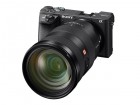
When the A6500 was first announced, I wrote briefly about my bewilderment at Sony’s release strategy. The camera was released only eight months after its predecessor – the a6300 – presumably in hopes of halting growing momentum from their competitors in the mirrorless market.
The Canon M5, Panasonic GX85 and G85, Fuji XT-2, and Olympus OM-D E-M1 Mark II all followed the A6300, and perhaps Sony want to lock people onto their mount before their market share gets further diluted. Camera sales across all categories are down this year, with mirrorless sales also dipping, so it's important for Sony to get as many photographers on the E-mount as quickly as possible.
While the a6300 was shipped in March to plenty of fanfare, the initial positive response from customers soon turned a little more lukewarm due to well-documented issues related to overheating and the extensive rolling shutter while recording video. Customers quickly found out the a6300 couldn’t actually record 4K footage at the advertised time of 29 min 50 seconds, because the camera would overheat – even in normal temperature situations.
Over in England, Kai met up with (frequent DRTV guest) Dan Chung of Newsshooter at a Sony EU press conference. Dan was testing the a6500’s new ‘Auto PWR OFF Temp’ function and found that when set to HIGH, it allowed the camera to properly record footage up to the 29 min 50 second limit. That’s great news. But again, why can’t the a6300 do that consistently? It was advertised as being able to in official press releases, and the fact that it’s seen as a “feature” or upgrade on the a6500 is laughable. This is no upgrade – it’s a fix on a flawed core function of the a6300, and it should have been addressed by Sony engineers before the launch of the a6500’s predecessor.
This is no upgrade – it’s a fix on a flawed core function of the a6300, and it should have been addressed by Sony engineers before the launch of the a6500’s predecessor.
Then we have the fact that while the a6500 has an improved processor compared to the a6300, the sensor is exactly the same. So how does this fix the rolling shutter issue that has plagued the a6300? From all accounts, so far the pre-production models have shown that there are zero improvements on the problem. Sony clearly don’t think it’s something worth fixing – but honestly, if they are asking US$400 more, this is just contempt on their part for the consumer.
We tested it out here as well at a recent press conference, and found absolutely no improvement. A well-known videographer at the event expressed significant dismay at that discovery since he appreciates the compact size of the a6000 series, but still tends to stick to the a7 series for reliability. Our video team at DigitalRev have also found the a6300’s rolling shutter issues unusable, and hence we’ve been using the excellent a7S II. If the a6500 still offers no improvement, why should anyone interested in buying it for video recording even bother?
Which brings us on to our next point – everyone who saw the body of the a6300 decried the lack of a headphone socket. It would be obvious for a replacement model like the a6500 to actually include one, especially given its premium price tag. However, like its predecessor, the a6500 has a mic input, but no slot for the videographer to actually listen to the audio. This is baffling. To once again cite Dan Chung, if anyone wants to hear anything during recording they’ll have to pull tricks like, “adding a HDMI monitor with a headphone jack, which records to an external recorder with its own audio input, using a mixer that you monitor before feeding to the camera, or using one of Sony’s MI shoe connected wireless microphone receivers and monitoring through the headphone jack on it. ”
That's clearly not a very ideal situation, so we can only assume that Sony believe having a headphone socket isn't a priority. Sounds a bit like Apple to me, except Sony doesn't even offer a Lightning cable option.
Of course the a6500 does have some improvements. The IBIS seems to work well, but then again, it’s just recycled tech from the a7S II and a7R II. The camera body has a slightly larger grip, and there are now two custom buttons on the top. The new menu looks great, and provides a more intuitive browsing system. The touch focus is the highlight of the entire camera, and truly is a smart bit of tech. You can select objects just by clicking on them, and then the camera can switch to AF tracking on that subject. When you use the EVF, you can drag the focus marker around with your finger like on the Canon M5. The Canon M5’s touch focus seemed a bit faster with Dual Pixel AF, but this is still very impressive. We look forward to seeing it improved on the next generation a7 models, which will probably be announced next year.
It should be noted that we only handled a pre-production model, which is why we weren’t allowed to export any photos or videos. But since the a6500 will be shipping out in early December, there’s little time left for Sony to make any significant changes at this late stage. I strongly do believe in my original statement that Sony effectively screwed over its customers by not releasing a better version of the A6300, but that was still under the assumption that the a6500 would have at least fixed most of the issues encountered by the a6300. After handling the a6500 however, I’m even more shocked at how little Sony has done with regards to issues that its predecessor had. We’ll reserve our final judgement until the camera is properly released, so stay tuned for the video team to take the a6500 to task.
. digitalrev.com
2016-10-28 03:00






